"Japan's Economic and Freight Outlook" and "Short-term Survey of Freight Movement in Japan (Nittsu Soken Tan-kan)"
February 10, 2021

Nittsu Research Institute and Consulting, lnc. (NRIC), one of the subsidiaries of Nippon Express, publishes "Japan's Economic and Freight Outlook" and "Short-term Survey of Freight Movement in Japan (Nittsu Soken Tan-kan)" quarterly. For more historical details of the surveys, kindly refer to the last paragraph of this article.
Summary of the results of "Japan's Economic and Freight Outlook for FY2020 and 2021" (published on 25th December 2020)
●Economy
Although the Global economy is projected to shrink by 4.4% in 2020 mainly due to the COVID-19 pandemic, 5.2% increase is expected for 2021 (IMF forecast).
The Japanese economy has been heavily damaged by the consumption tax hike in October 2019 as well as the COVID-19 crisis. The real economic growth rate in FY2020* is estimated to be 5.3% decrease. For 2021, it is expected to turn positive with 3.5% increase, however, the movement will lack strength.
In Japan, the government's financial year is from 1st April to 31th March.
●Domestic freight transport of Japan
In the first half of FY2020, in addition to the COVID-19 crisis, the consumption tax hike in the previous year also had an impact and freight volume of all commodities declined significantly. Although the negative margin is expected to shrink somewhat in the second half, sluggish movements will continue, centered on production-related freight, amid stagnant capital investment and industrial production. For the full FY 2020, it is forecast to decrease by 7.0%, which is lower than that of 2009 (6.0% decrease) after the Lehman Brothers crisis.
In FY2021, it will turn positive for the first time in four years, but the increase is only by 1.7%. Due to the reaction to the sharp decrease in the previous year, consumption-related freight will increase by 3%. Production-related freight is expected to grow by only about 4%, well below the level in FY2019. Although public works spending is expected to increase, construction-related freight will continue to decline by about 2%, as large-scale civil engineering work is not expected to be executed.
Rail freight
The freight volume by JR (Japan Railway) containers is projected to decrease by 7.3% in FY2020, since the volume of most commodities fell below the previous year's level due to the economic downturn caused by the COVID-19 crisis. As new lifestyles such as remote work have become common, the negative range of paper and pulp has expanded. Eco-related supplies (such as the construction surplus soil of the Linear Chuo Shinkansen) have positive growth. Automobile parts are expected to recover after the beginning of the year. Although the freight volume by JR containers is expected to rise by 5.6% in FY2021, it would not return to the level of FY2019. In addition to the reaction of the sharp decrease in the previous year, it increased due to the effect of new trains dedicated for freight transportation. Temporary relief from the shortage of truck drivers is also a negative factor for rail freight transport.
As for JR wagonload freight, oil demand has declined significantly due to self-restraint from going out and production activities restraints. In FY2020, it is forecast to decrease by 5.6% because of a significant decline in oil demand. Although it may be greatly depending on the weather, it would be expected to increase by 1.2% in FY2021 owing to the recovery of oil demand, the first increase in 4 years since 2017.
Rail freight transport other than JR is expected to decrease by 9.9% in FY2020 and increase by 4.9% in FY2021, mainly because of the increase in oil, cement, and limestone.
Motor freight
As a result of the COVID-19 crisis, all commodities have decreased significantly, and commercial motor freight is forecast to decline by 7.0% in FY2020. In particular, due to stagnant industrial production and capital investment, production-related freight would decrease by nearly 10%, greatly pushing down the motor freight volume. In reaction to the sharp decrease in the previous year, it is expected to increase by 2.5% in FY2021 and turn positive for the first time in two years. Consumption-related freight and production-related freight remained firm due to the recovery of personal consumption, capital investment, and mining and industrial production. Construction-related freight remains low as housing construction is sluggish and large-scale public civil engineering work is not expected to be executed.
Coastal shipping freight
Freight transport by coastal shipping is expected to decrease by 10.2% in FY2020 and increase by 3.9% in FY2021. In FY2020, production-related freight and construction-related freight is forecast to fall sharply. However, in FY2021, production is expected to pick up and forecast to increase by 3.9%, the first increase in eight years since 2013. This is mainly due to a rise in petroleum products, steel, chemical industry products, etc.
Domestic airfreight
Domestic airfreight is expected to decrease sharply by 33.3% in FY2020, owing to low demand and a decline in supply capacity of aircrafts caused by the self-restraint from going out during the COVID-19 crisis. In FY2021, it is projected to increase by 27.2%, for the first time in 8 years since 2013, with a positive reversal from the previous year. While a big rise in demand cannot be expected, it would return about half of the decrease in the previous year at most.
Table1: Outlook for domestic freight transport of Japan
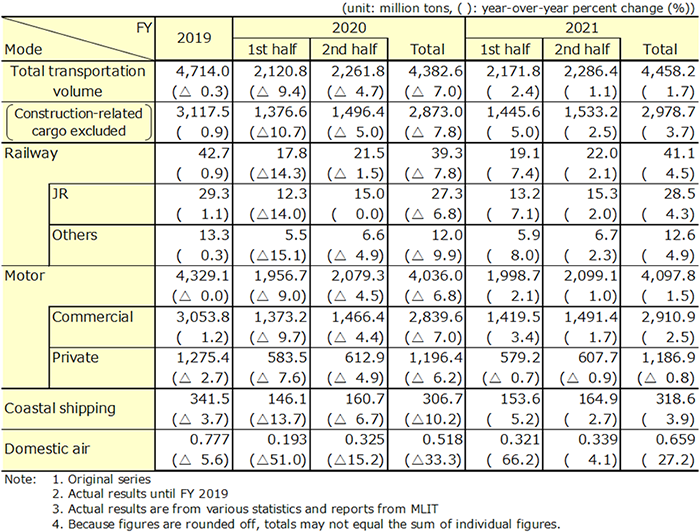
●International freight transport from/to Japan
International ocean container freight
Exports by international ocean containers are expected to decrease by 10.9% in FY2020 and increase by 6.5% in FY2021, turning positive but not reaching the level before COVID-19 (FY2019). Following the settling down of the COVID-19 pandemic and the gradual recovery of the world economy, it is expected to turn positive for the first time in three years. By commodity, overseas capital investment demand gradually recovers, and freight movements of general machinery such as construction machinery and industrial machinery also recovers in the second half. With regard to automobile parts, the recovery trend of the global automobile market is expanding, and freight movements are becoming more active. The new trade agreement (UK-Japan EPA and RCEP: Regional Comprehensive Economic Partnership Agreement in East Asia) is expected to boost and support exports to Europe and Asia.
Imports by international ocean containers are expected to decrease by 3.6% in FY2020 and increase by 2.5% in FY2021, turning positive for the first time in three years. The impact of the consumption tax hike has come to an end for personal consumption, and the recovery trend is expanding. In response to this, consumer goods are expected to move actively from the first half. Capital investment recovered moderately in the second half, and imports of production parts/components and machinery increased slightly from the previous year. In the July-September period, there is a possibility that it will be pushed up due to the reaction to the sharp decrease in the previous year. The domestic return of overseas production bases and the progress of domestic procurement increase are the downward factors.
Table2: Outlook for international ocean container freight of Japan
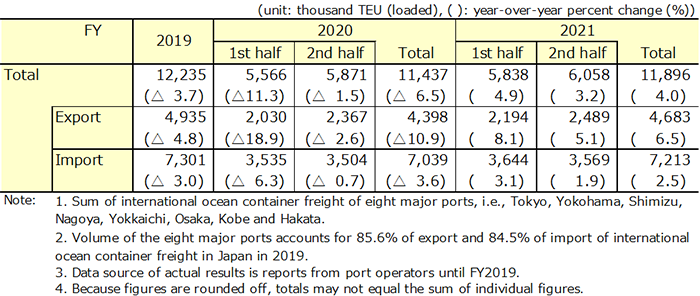
International airfreight
International airfreight exports are expected to decrease by 11.4% in FY2020 and increase by 12.8% in FY2021, turning to a double-digit positive, and recovering to the same level as before COVID-19 (FY2019). The Pacific and European routes increase in the high 10% range due to the settling down of COVID-19 and the reaction to the sharp decrease in the previous year. The rate of increase on the Asian routes has expanded, and although the increase has slowed somewhat in the second half, it will increase by double digits for the entire fiscal year. Sales of semiconductors (electronic parts and manufacturing equipment) have been firm due to the full-scale spread of AI, IoT, and 5G. As for automobile parts, demand related to EV shift and electrical equipment is rising, and the increase in sales is expanding, which will be a driving force for recovery. Machinery such as general machinery and machine tool parts will gradually pick up in response to the recovery in demand for overseas capital investment.
International airfreight imports are expected to decline by 9.4% in FY2020 and increase by 3.4% in FY2021, turning positive for the first time in four years, surpassing the previous year's level. As for consumer goods, the increase in sales expanded in the first half due to the recovery of personal consumption, and freight movements are recovering. The reduction in import tariffs owing to the new trade agreement (Japan-UK EPA / RCEP agreement) is also a factor pushing up. Production goods such as electronic parts and mechanical parts including semiconductors, capital investment gradually recover in the second half and turns positive, albeit slightly. The downward factors are the return of overseas production bases aiming to reduce dependence on China and the progress of domestic procurement of parts and components. In the April-June period, it is expected to be boosted by an emergency increase in imports of pharmaceuticals and medical products such as COVID-19 vaccines.
Table3: Outlook for international airfreight of Japan
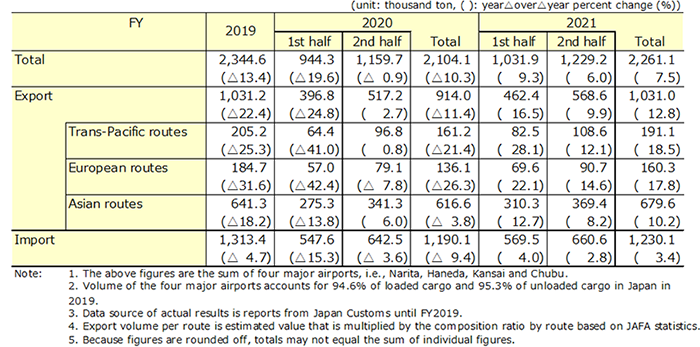
Read full report of "Japan's Economic and Freight Outlook" (Japanese only)
https://www.nittsu-soken.co.jp/wp-content/uploads/2020/12/report-20201225.pdf
Summary of the results of "Short-term Freight Movement Survey in Japan (Nittsu Soken Tan-kan)" (December 2020 survey, published on 28th January 2021)
In the December 2020 survey, questionnaires are sent to 2,500 major manufacturing and wholesale business establishments in Japan and we received responses from 838 business establishments. The response rate was 33.5%.
●Trends in domestic shipment volume (freight movement index)
The "freight movement index" in the October-December 2020 results (expected) shows a significant increase and further increase is expected in January-March 2021 forecast. The index for October-December 2020 is minus 40, which is 19 points higher than the previous term (July- September 2020). The index for the January-March 2021 forecast is minus 34, increased further by 6 points from the current term (October-December 2020).
Graph1: Results and prospects for domestic shipment volume
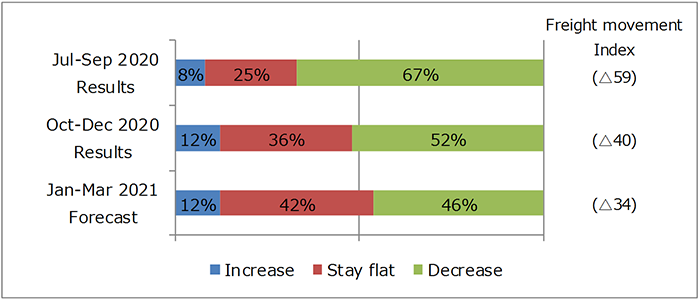
●Changes in the "Freight Movement Index" (2016-2020)
After falling in January-March 2018 and April-June 2018, the index increased again in July-September 2018 and October-December 2018, indicating a "business peak".
A sharp decrease of 17 points in the January-March 2019 results and 7 points in the April-June 2019 results suggest a deterioration in the economy. Although it recovered 1 point in the July-September 2019 results, it decreased again in the October-December 2019 results because of the consumption tax hike, and further decreased in the January-March 2020 results.
In the April-June 2020 results, the impact of the COVID-19 crisis was severely affected, resulting in a significant decline in the index. It was the lowest level after January-March 2009 (-75) and April-June 2009 (-69) after the Lehman Brothers crisis.
The July-September 2020 results turned up. The index increased further in the October-December 2020 results and the outlook for January-March 2021 term.
Graph2: Changes in the "Freight Movement Index" (2017-2021)
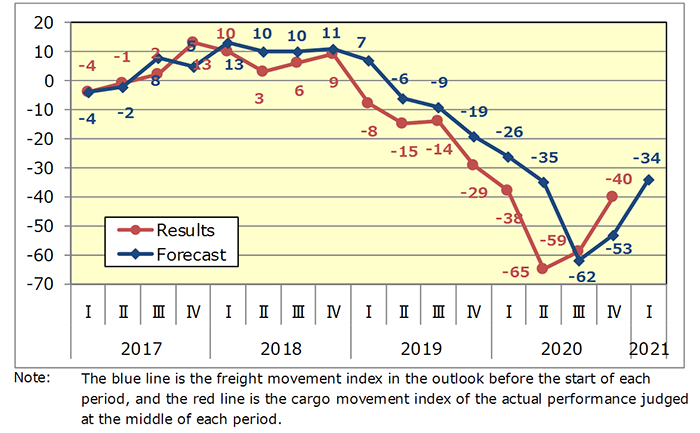
Graph3: Freight movement index by industry
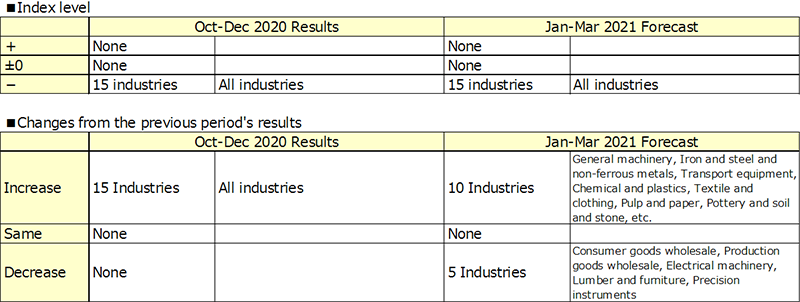
Table4: Results and prospects for domestic shipment volume by industry
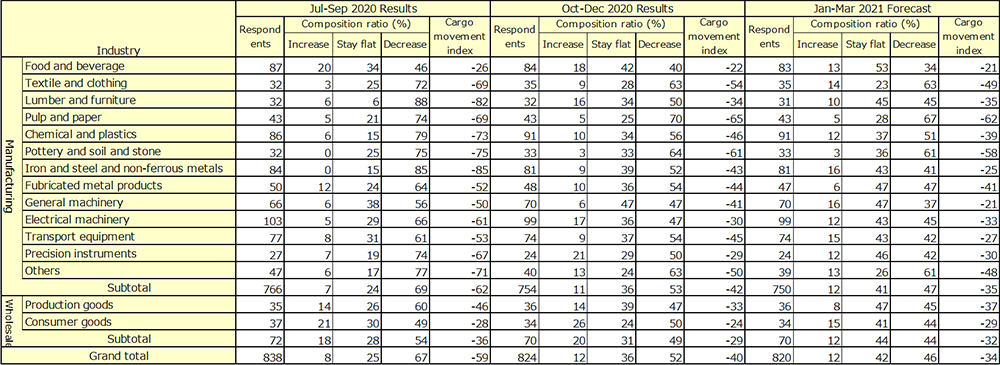
Read full report of "Short-term Freight Movement Survey in Japan (Nittsu Soken Tan-kan)" (Japanese only)
https://www.nittsu-soken.co.jp/wp-content/uploads/2021/01/tankan2020-12.pdf
"Japan's Economic and Freight Outlook" is a survey that has continued for over 40 years since the first survey in 1974. The purpose is to investigate and analyse the trends of Japanese economy and freight transport volume of domestic freight and international freight of Japan, and to predict short-term trends of six months to one year ahead. While many research institutes carry out economic forecasts, there is no other institution that makes full-scale forecasts of Japanese freight transport.
"Short-term Survey of Freight Movement in Japan (Nittsu Soken Tan-kan)" is one and only diffusion index survey on freight movements in Japan. Its first survey was conducted in October 1988 with the aim of grasping the latest trends in corporate logistics. Since then, it has continued at a pace of twice a year (1st half and 2nd half) and since 2002, it has been conducted quarterly.
Questionnaires are sent to 2,500 major manufacturing and wholesale business establishments in Japan and the response rate is approximately 30-40%. Respondents are asked to select from the three options of "increase", "stay flat", "decrease" for the actual results (expected) for the current period and the forecast for the next period for 6 items (domestic shipment volume, transport mode, import/export freight volume, inventory, freight charges and distribution cost ratio). Then, the number of responding companies for each option is aggregated for each survey item, and the ratio to the total number of business establishments is calculated and presented as a trend judgment index.
Reference:
- Nittsu Research Institute and Consulting, lnc., "Japan's Economic and Freight Outlook" (Japanese only)
https://www.nittsu-soken.co.jp/wp-content/uploads/2020/12/report-20201225.pdf - Nittsu Research Institute and Consulting, lnc., "Short-term Survey of Freight Movement in Japan (Nittsu Soken Tan-kan)" (Japanese only)
https://www.nittsu-soken.co.jp/wp-content/uploads/2021/01/tankan2020-12.pdf